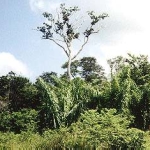| Common Name: |
Tonka Bean |
| Other Names: |
Cumaru, Dutch Tonka, English Tonka, Tonka, Tonka Seed, Tonquin bean |
| Botanical Name: |
Dipteryx odorata syn. Coumarouna odorata |
| Genus: |
Dipteryx |
| Family: |
Fabaceae |
| Location: |
S America, mainly Venezuela |
| Cultivation: |
Well-drained, gravelly or sandy, acid soil, with ample rainfall and humidity. Remove leading shoots of saplings when 2m (6ft) tall. |
| Propagation: |
By fresh seed sown in situ, which takes about 6 weeks to germinate. Seedlings do not transplant well. |
| Harvest: |
Fallen, ripe fruits are collected and dried to remove seeds, which are then cured by soaking in rum for 2-3 days. This process causes the coumarin to crystalize on the surface, known as "frosting". |
| Height: |
25-40m (80-130ft) |
| Width: |
15-20m (50-70ft) |
Hardiness: |
Min. 15-18°C (59-64°F) depending on cultivar. |
| Parts Used: |
Seeds |
| Chemical Constituents: |
Coumarin
Gum
Sitosterin
Starch
Stigmasterin
Sugar
|
| Properties: |
An aromatic herb taht improves the lasting qualities of perfumes. |
| Known Effects: |
Delays or stops blood clotting
Anticoagulant
Miscellaneous Information:
Coumarin interferes with the synthesis of vitamin K in the human intestines. The absence of vitamin K prevents blood clotting.
The tonka bean was once a common adulterant of vanilla extracts.
It's used as flavoring in tobacco
The FDA has banned its use as a flavoring agent in foods.
|
| Possible Additional Effects: |
May prevent clotting in deep veins
May prevent blood clots from breaking away from blood vessels and lodging in vital organs, such as lung or brain (use must be monitored carefully with frequent laboratory studies of prothrombin time)
|
| Medicinal Uses: |
Formerly used to treat whooping cough.
To treat cramps, nausea, cough, spasms, tuberculosis, earache, mouth ulcers, and sore throat; as an aphrodisiac. |
| Possible Side Effects: |
Tonka bean's side effects include nausea, vomiting, diarrhea, insomnia, and dizziness. |
| Drug Interactions: |
| Taking tonka beans with these drugs may increase the risk of bleeding or bruising: |
| Antithrombin III, (Thrombate III) |
Aminosalicylic Acid, (Nemasol Sodium, Paser) |
Aspirin, (Bufferin, Ecotrin) |
Choline Magnesium Trisalicylate, (Trilisate) |
| Choline Salicylate, (Teejel) |
Salsalate, (Amgesic, Salflex) |
Argatroban, (Argatroban) |
Bivalirudin, (Angiomax) |
| Dalteparin, (Fragmin) |
Danaparoid, (Orgaran) |
Enoxaparin, (Lovenox) |
Fondaparinux, (Arixtra) |
| Heparin, (Hepalean, Hep-Lock) |
Lepirudin, (Refludan) |
Tinzaparin, (Innohep) |
Warfarin, (Coumadin, Jantoven) |
|
| Warnings and Precautions: |
Don't take if you:
Are pregnant, think you may be pregnant, or plan pregnancy in the near future.
Consult your doctor if you:
Take this herb for any medical problem that doesn't improve in 2 weeks (There may be safer, more effective treatments.)
Take any medicinal drugs or herbs, including aspirin, laxatives, cold and cough remedies, antacids, vitamins, minerals, amino acids, supplements, other prescription or non-prescription drugs
Pregnancy:
Dangers outweigh any possible benefits. Don't use.
Breastfeeding:
Dangers outweigh any possible benefits. Don't use.
Infants and Children:
Treating infants and children under 2 with any herbal preparation is hazardous.
Others:
Dangers outweigh any possible benefits. Don't use.
Storage:
Store in cool, dry area away from direct light, but don't freeze.
Store safely out of reach of children.
Don't store in bathroom medicine cabinet. Heat and moisture may change the action of the herb.
Safe Dosage:
Consult your doctor for the appropriate dose for your condition.
|
| Adverse Reactions, Side Effects, or Overdose Symptoms: |
| Signs and Symptoms |
What to do |
|
| Growth Retardation |
Discontinue. Call doctor when convenient. |
| Jaundice (yellow skin and eyes) |
Discontinue. Call doctor when convenient. |
| Testicle Atrophy |
Discontinue. Call doctor when convenient. |
| Uncontrollable Internal Bleeding |
Seek emergency treatment |
|
| Disease Effects: |
May cause liver toxicity due to the coumarin in tonka bean. |
| Economic Uses: |
Used as a vanilla substitute for flavoring candy, cocoa, liqueurs, and medicinal preparations, such as cod liver oil. (Banned in some countries including the USA); perfume fixative in potpourris and scented goods; also used as an aromatic ingredient in tobaccos and snuff. |
| Bibliography: |
Encylopedia of Herbs by Deni Brown Copyright ©: 1995, 2001 Dorling Kindersley Limited pg 195
The Essential Herb-Drug-Vitamin Interaction Guide by Geo. T. Grossberg,MD and Barry Fox,PhD Copyright©2007 Barry Fox,PhD. Pp.453-454
Vitamins, Herbs, Minerals & Supplements The Complete Guide by H. Winter Griffith, MD Copyright©1998 Fisher Books pp. 452-453 |

